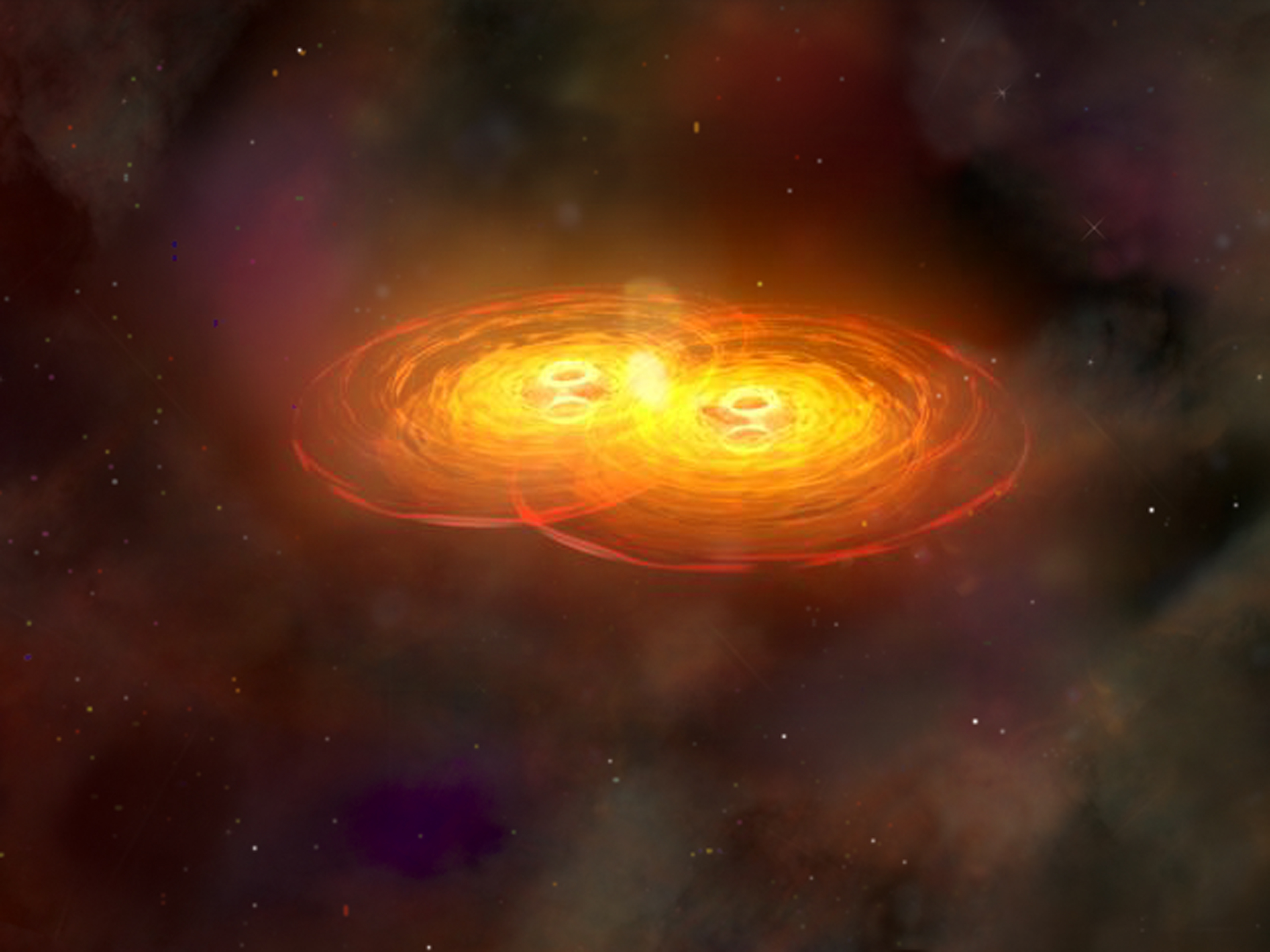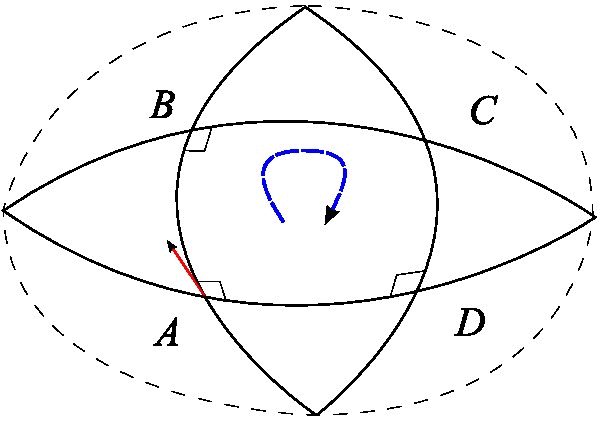|
Holst Action
In the field of theoretical physics, the Holst action is an equivalent formulation of the Palatini action for General Relativity (GR) in terms of vierbeins (4D space-time frame field) by adding a part of a topological term (Nieh-Yan) which does not alter the classical equations of motion as long as there is no torsion, :S = \frac \int e e^_ e^_ (F_^ - \alpha \ast F_^) \equiv \frac \int e e^_ e^_ (F_^ - \frac \epsilon^_ F_^) where e^_ is the tetrad, e its determinant (the space-time metric is recovered from the tetrad by the formula g_=e_^e_^\eta _ where \eta_ the Minkowski metric), F_^ the curvature considered as a function of the connection A_^: :F_^ = ^ = 2 \partial_ ^ + 2^ ^J, \alpha a (complex) parameter, and where we recover the Palatini action when \alpha = 0. It only works in 4D. To be torsion free means the covariant derivative defined by the connection A_^ when acting on the Minkowski metric \eta_ vanishes, implying the connection is anti-symmetric in its interna ... [...More Info...] [...Related Items...] OR: [Wikipedia] [Google] [Baidu] |
Theoretical Physics
Theoretical physics is a branch of physics that employs mathematical models and abstractions of physical objects and systems to rationalize, explain and predict natural phenomena. This is in contrast to experimental physics, which uses experimental tools to probe these phenomena. The advancement of science generally depends on the interplay between experimental studies and theory. In some cases, theoretical physics adheres to standards of mathematical rigour while giving little weight to experiments and observations.There is some debate as to whether or not theoretical physics uses mathematics to build intuition and illustrativeness to extract physical insight (especially when normal experience fails), rather than as a tool in formalizing theories. This links to the question of it using mathematics in a less formally rigorous, and more intuitive or heuristic way than, say, mathematical physics. For example, while developing special relativity, Albert Einstein was concer ... [...More Info...] [...Related Items...] OR: [Wikipedia] [Google] [Baidu] |
Ashtekar Variables
In the ADM formulation of general relativity, spacetime is split into spatial slices and a time axis. The basic variables are taken to be the induced metric q_ (x) on the spatial slice and the metric's conjugate momentum K^ (x), which is related to the extrinsic curvature and is a measure of how the induced metric evolves in time. These are the metric canonical coordinates. In 1986 Abhay Ashtekar introduced a new set of canonical variables, Ashtekar (new) variables to represent an unusual way of rewriting the metric canonical variables on the three-dimensional spatial slices in terms of an SU(2) gauge field and its complementary variable. Overview Ashtekar variables provide what is called the connection representation of canonical general relativity, which led to the loop representation of quantum general relativity and in turn loop quantum gravity and quantum holonomy theory. Let us introduce a set of three vector fields E^a_i, i = 1,2,3 that are orthogonal, that is, :\delta_ ... [...More Info...] [...Related Items...] OR: [Wikipedia] [Google] [Baidu] |
Spin Foam
In physics, the topological structure of spinfoam or spin foam consists of two-dimensional faces representing a configuration required by functional integration to obtain a Feynman's path integral description of quantum gravity. These structures are employed in loop quantum gravity as a version of quantum foam. In loop quantum gravity The covariant formulation of loop quantum gravity provides the best formulation of the dynamics of the theory of quantum gravity – a quantum field theory where the invariance under diffeomorphisms of general relativity applies. The resulting path integral represents a sum over all the possible configurations of spin foam. Spin network A spin network is a one-dimensional graph, together with labels on its vertices and edges which encode aspects of a spatial geometry. A spin network is defined as a diagram like the Feynman diagram which makes a basis of connections between the elements of a differentiable manifold for the Hilbert spaces ... [...More Info...] [...Related Items...] OR: [Wikipedia] [Google] [Baidu] |
Lattice Gauge Theory
In physics, lattice gauge theory is the study of gauge theories on a spacetime that has been discretized into a lattice. Gauge theories are important in particle physics, and include the prevailing theories of elementary particles: quantum electrodynamics, quantum chromodynamics (QCD) and particle physics' Standard Model. Non-perturbative gauge theory calculations in continuous spacetime formally involve evaluating an infinite-dimensional path integral, which is computationally intractable. By working on a discrete spacetime, the path integral becomes finite-dimensional, and can be evaluated by stochastic simulation techniques such as the Monte Carlo method. When the size of the lattice is taken infinitely large and its sites infinitesimally close to each other, the continuum gauge theory is recovered. Basics In lattice gauge theory, the spacetime is Wick rotated into Euclidean space and discretized into a lattice with sites separated by distance a and connected by links. In ... [...More Info...] [...Related Items...] OR: [Wikipedia] [Google] [Baidu] |
Loop Quantum Gravity
Loop quantum gravity (LQG) is a theory of quantum gravity, which aims to merge quantum mechanics and general relativity, incorporating matter of the Standard Model into the framework established for the pure quantum gravity case. It is an attempt to develop a quantum theory of gravity based directly on Einstein's geometric formulation rather than the treatment of gravity as a force. As a theory LQG postulates that the structure of space and time is composed of finite loops woven into an extremely fine fabric or network. These networks of loops are called spin networks. The evolution of a spin network, or spin foam, has a scale above the order of a Planck length, approximately 10−35 meters, and smaller scales are meaningless. Consequently, not just matter, but space itself, prefers an atomic structure. The areas of research, which involves about 30 research groups worldwide, share the basic physical assumptions and the mathematical description of quantum space. Research has ev ... [...More Info...] [...Related Items...] OR: [Wikipedia] [Google] [Baidu] |
Self-dual Palatini Action
Ashtekar variables, which were a new canonical formalism of general relativity, raised new hopes for the canonical quantization of general relativity and eventually led to loop quantum gravity. Smolin and others independently discovered that there exists in fact a Lagrangian formulation of the theory by considering the self-dual formulation of the Tetradic Palatini action principle of general relativity. These proofs were given in terms of spinors. A purely tensorial proof of the new variables in terms of triads was given by Goldberg and in terms of tetrads by Henneaux et al. The Palatini action The Palatini action for general relativity has as its independent variables the tetrad e_I^\alpha and a spin connection ^. Much more details and derivations can be found in the article tetradic Palatini action. The spin connection defines a covariant derivative D_\alpha. The space-time metric is recovered from the tetrad by the formula g_ = e^I_\alpha e^J_\beta \eta_. We define the `cur ... [...More Info...] [...Related Items...] OR: [Wikipedia] [Google] [Baidu] |
Bianchi Identity
In differential geometry, the curvature form describes curvature of a connection on a principal bundle. The Riemann curvature tensor in Riemannian geometry can be considered as a special case. Definition Let ''G'' be a Lie group with Lie algebra \mathfrak g, and ''P'' → ''B'' be a principal ''G''-bundle. Let ω be an Ehresmann connection on ''P'' (which is a \mathfrak g-valued one-form on ''P''). Then the curvature form is the \mathfrak g-valued 2-form on ''P'' defined by :\Omega=d\omega + omega \wedge \omega= D \omega. (In another convention, 1/2 does not appear.) Here d stands for exterior derivative, cdot \wedge \cdot/math> is defined in the article " Lie algebra-valued form" and ''D'' denotes the exterior covariant derivative. In other terms, :\,\Omega(X, Y)= d\omega(X,Y) + omega(X),\omega(Y)/math> where ''X'', ''Y'' are tangent vectors to ''P''. There is also another expression for Ω: if ''X'', ''Y'' are horizontal vector fields on ''P'', thenProof: \sigma\Omeg ... [...More Info...] [...Related Items...] OR: [Wikipedia] [Google] [Baidu] |
Palatini Action
The tetrad formalism is an approach to general relativity that generalizes the choice of basis for the tangent bundle from a coordinate basis to the less restrictive choice of a local basis, i.e. a locally defined set of four linearly independent vector fields called a '' tetrad'' or ''vierbein''. It is a special case of the more general idea of a ''vielbein formalism'', which is set in (pseudo-) Riemannian geometry. This article as currently written makes frequent mention of general relativity; however, almost everything it says is equally applicable to (pseudo-)Riemannian manifolds in general, and even to spin manifolds. Most statements hold simply by substituting arbitrary n for n=4. In German, "vier" translates to "four", and "viel" to "many". The general idea is to write the metric tensor as the product of two ''vielbeins'', one on the left, and one on the right. The effect of the vielbeins is to change the coordinate system used on the tangent manifold to one that is s ... [...More Info...] [...Related Items...] OR: [Wikipedia] [Google] [Baidu] |
Riemann Tensor
In the mathematical field of differential geometry, the Riemann curvature tensor or Riemann–Christoffel tensor (after Bernhard Riemann and Elwin Bruno Christoffel) is the most common way used to express the curvature of Riemannian manifolds. It assigns a tensor to each point of a Riemannian manifold (i.e., it is a tensor field). It is a local invariant of Riemannian metrics which measures the failure of the second covariant derivatives to commute. A Riemannian manifold has zero curvature if and only if it is ''flat'', i.e. locally isometric to the Euclidean space. The curvature tensor can also be defined for any pseudo-Riemannian manifold, or indeed any manifold equipped with an affine connection. It is a central mathematical tool in the theory of general relativity, the modern theory of gravity, and the curvature of spacetime is in principle observable via the geodesic deviation equation. The curvature tensor represents the tidal force experienced by a rigid body moving a ... [...More Info...] [...Related Items...] OR: [Wikipedia] [Google] [Baidu] |
Einstein Tensor
In differential geometry, the Einstein tensor (named after Albert Einstein; also known as the trace-reversed Ricci tensor) is used to express the curvature of a pseudo-Riemannian manifold. In general relativity, it occurs in the Einstein field equations for gravitation that describe spacetime curvature in a manner that is consistent with conservation of energy and momentum. Definition The Einstein tensor \mathbf is a tensor of order 2 defined over pseudo-Riemannian manifolds. In index-free notation it is defined as \mathbf=\mathbf-\frac\mathbfR, where \mathbf is the Ricci tensor, \mathbf is the metric tensor and R is the scalar curvature, which is computed as the trace of the Ricci Tensor R_ by R = g^R_ = R_\mu^\mu. In component form, the previous equation reads as G_ = R_ - g_R . The Einstein tensor is symmetric G_ = G_ and, like the on shell stress–energy tensor, and has zero divergence: \nabla_\mu G^ = 0\,. Explicit form The Ricci tensor depends only on the metr ... [...More Info...] [...Related Items...] OR: [Wikipedia] [Google] [Baidu] |



